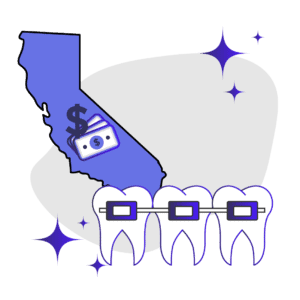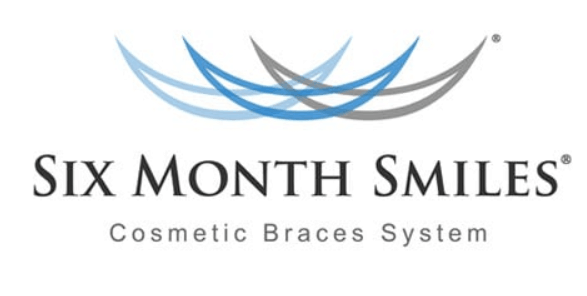
Braces have been around for decades, and there’s a good reason they remain a go-to teeth straightening option for adults everywhere: they work. But one thing that isn’t so certain about braces is treatment cost. It isn’t a one-size-fits-all number — it depends on a variety of factors, including your location.
You might pay one amount in California, but a friend could pay something completely different in Illinois, Pennsylvania, or Texas. This guide discusses all the factors that contribute to California’s braces costs to help you get a sense of what you’ll pay.
Table of Contents
Cost of Adult Braces in California vs. National Average
According to the American Dental Association, the national average cost for adult braces treatment is $4,800 to $7,135. But in California, land of beachfront vistas and movie star allure, you’ll likely end up paying more. The state’s high cost of living and taxes make it one of the most expensive states for adult braces.
| Area | Cost in California | National Average |
|---|---|---|
| Urban | $6,000–$9,000 | $5,250 |
| Suburban | $5,000–$9,000 | $5,500 |
| Rural | $4,500–$7,500 | $5,000 |
These ranges are estimates based on what we know about adult braces costs and some information from a few California-based orthodontists. But they should give you a general sense of what you might pay.
Why Are Braces So Expensive?
There’s no getting around the fact that braces are expensive. But that’s because they’re one of the most consistent and effective treatments available.
They might be visible and somewhat intrusive, but braces’ major benefit is their sturdiness. You can’t take them out like clear aligners, so they eliminate the potential for user error. Sure, you need to avoid excessively sticky or gummy foods, but in return, you’re getting surefire results. Metal brackets and wires give an orthodontist incredible control over your teeth, and during routine office visits, they can make adjustments to deliver the perfect results.
Braces require routine trips to the orthodontist over the course of a 12–24 month treatment timeline, and each visit costs money. Orthodontist offices have overhead costs like rent, utilities, and staff, which translate to patient fees. And don’t forget that you’re also paying for the orthodontist’s expertise and time. However, as you’ll find out, the price you ultimately pay is subject to a variety of influences, including where you live.
Looking For Affordable Orthodontic Treatment in California?
Braces are a time-tested treatment, but their price tag doesn’t fit every budget. That’s why adults with mild misalignments sometimes opt for at-home aligners instead.
By cutting office visits out of the equation, home aligner companies like Byte and SmileDirectClub offer comparable services for lower prices. We’ve done extensive research on home aligner options. Our in-depth guide provides all the info you need to find the best option for your smile.
What Factors Influence the Cost of Braces?
Braces are typically expensive. But exactly how expensive is a more complicated question. Multiple factors can influence your final bill. Some are based on your location, others are constant across state lines. We break them all down in detail below.
Condition Severity
This is the most significant price-determining factor. A minor case of crowding or spacing simply takes less time and aligners to correct than a severe case of crossbite. The fewer office visits your teeth require, the less you’ll pay. During your initial consultation, your dentist/orthodontist can evaluate your teeth and estimate how long your treatment might take.
Type of Braces
Orthodontic technology has advanced significantly over the past couple of decades, and standard metal brackets aren’t the only option anymore. For instance, you can opt for ceramic braces that blend in with your teeth, or lingual braces that sit behind your teeth. Each of these is less noticeable than traditional braces, but they’re also more expensive. Ceramic braces can cost up to $8,000, while lingual braces can be between $8,000 and $13,000.
Region
In general, orthodontic care costs more on the coasts and less in the middle of the country. The northeast is particularly expensive, while southern states like Alabama and Mississippi boast some of the nation’s lowest costs. Taxes can also play a role. The state will add sales tax to your total braces cost, and higher corporate taxes might cause your orthodontist to accommodate by raising prices.
California is big. Some parts feel like southwest desert while others are chic, sunny beach towns. The state contains cities of all sizes and plenty of geographic diversity. But as a West Coast state with high taxes and a high cost of living, California’s braces prices are typically higher than other states, no matter which part of the state you call home. The northeast might have slightly higher average orthodontic costs, but the West Coast is a very close second.
If you’re within driving distance, you might be able to find cheaper braces in Nevada or Arizona, which each have a lower cost of living and generally lower healthcare expenses. Some residents of southern California opt to get their orthodontic treatment in Tijuana, Mexico, just across the border near San Diego. And while this route is significantly cheaper, it’s also riskier, since it’s an unfamiliar city and country. Make sure you do plenty of research if you’re considering crossing the border for braces. Also, remember that braces require office visits every 4–6 weeks, so don’t go farther than you’d be willing to travel regularly.
And we can’t forget taxes. California’s sales and income taxes are both higher than average. The 7.25% sales tax will directly affect your treatment cost. The 8.84% corporate income tax makes it more expensive to run a business which, in turn, could cause your orthodontist to charge more for treatment.
Urban, Suburban, or Rural?
Not only are orthodontic costs different for each state, but they also vary based on your location within the state. Urban areas, for example, often have a higher cost of living, and it’s less expensive to live in a small town. Do you have high rent and utility payments? Then your dentist or orthodontist likely does too. Higher overhead costs usually result in more expensive orthodontic treatment.
Urban
California’s two biggest urban hubs are Los Angeles (the nation’s second-largest city) and San Francisco. But California is the most populous state in the U.S., so it contains several other large cities, like San Diego, San Jose, Sacramento, and Bakersfield. Cities along the coast or around the Bay have a high cost of living, so you’ll likely pay more for braces, as high as $9,000 depending on your case. There are a ton of orthodontist options in these cities, so you still might be able to find a good deal. Cities in the central valley and eastern California — like Bakersfield and Fresno — have a lower cost of living, which means they often have lower braces costs too (but still higher than the national average).
Keep in mind that Los Angeles is a film production hub, full of movie stars, glitz, and glamour. This means it’s a hotspot for cosmetic orthodontia and a magnet for some of the best orthodontists in the U.S., who can sometimes charge much higher prices for their treatment.
Suburban
Los Angeles and San Francisco are sprawling urban areas surrounded by many suburbs, some affordable and others extremely expensive. So, orthodontic treatment prices in these suburbs can be comparable to what you’ll find in the city or, sometimes, even higher. California also has numerous independent mid-sized cities across the state. Generally, the closer to the coast a city is, the higher you’ll pay for braces. Coastal cities like Santa Barbara and Santa Cruz have higher costs of living, while central valley cities like Visalia and Tipton don’t cost quite as much. If you’re in the L.A. or San Francisco suburbs, even a more expensive one, you still have access to the city’s wealth of orthodontists, so you can shop around to find the best prices.
Rural
We’ll say it again: California is big. Not just in population, but in geographic area too. The state might evoke images of quaint surf towns and busy cities, but there’s a lot of open space in California too. Small towns, especially inland ones, are typically much more affordable places to live, and their orthodontic fees reflect it. The small towns along the coast, however, are sometimes popular vacation spots where braces can cost more.
Local Competition
When you have numerous orthodontists in an area, they each need to stay ahead of the competition and attract new customers. Many times, this means lower prices and special offers or sales. So, if there’s a high concentration of orthodontists in your area, it can mean lower prices, giving you the ability to “shop around.”
An orthodontist in one of California’s big cities has some stiff competition, especially in L.A with its high-profile dentists for the stars. And every business knows that to attract new customers, you need to set yourself apart. This is why orthodontists in high-competition areas will sometimes offer promotional discounts and run sales. Monitor orthodontist websites (or contact them directly) to jump on special offers for braces treatment.
Because they have fewer dentists and orthodontists overall, rural areas have lower levels of competition, so Invisalign providers are less likely to offer sales and promotions, although sometimes they still do.
Orthodontist Experience
Like most industries, in orthodontia, seasoned professionals can charge more for their services than relative newcomers. So, if your orthodontist has been administering braces for years, you might end up paying a bit more. For this reason, it can sometimes be helpful to “shop around” to weigh your options if you have multiple orthodontists nearby.
Managing Treatment Costs
If you’re feeling overwhelmed by treatment costs, you’re not alone. Take comfort in the fact that in most cases, you won’t have to pay the entire amount up front. Here are some ways you can make that price tag seem a little more manageable:
Review Your Insurance Plan
Braces for children and adolescents are partially covered by most dental insurance plans. However, plans don’t often cover costs for anyone over 18, unless they include orthodontic benefits. But you don’t want to begin treatment expecting help from your insurance provider, only to find out that it’s not coming. So don’t commit to braces without first reviewing your insurance plan and contacting your provider.
Some orthodontist offices also accept payments directly from an FSA or HSA if you have one. Consult your dentist or orthodontist to see how they handle these payments.
Search for Sales and Discounts
You won’t likely see your orthodontist running sales or promotional discounts on braces. But sometimes they’ll offer perks to go along with your treatment, like teeth whitening or a percentage off your next visit. It certainly can’t hurt to ask. Sometimes you can even find deals on Groupon.
Universities with dental and orthodontic schools will also offer discounts if you don’t mind a resident administering your treatment. These individuals are qualified and on the track to becoming state-licensed orthodontists. Plus, they’re overseen by professors and experienced dental professionals, so you can be sure you’re receiving quality care.
California has six dental schools, more than most other states, and five of them offer orthodontic services to the community. Around L.A., you can visit USC, UCLA, or Loma Linda University. And near the Bay Area, you’ve got UCSF and University of the Pacific.
Inquire about Financing Options
Most orthodontist offices offer financing plans that break your costs into manageable monthly payments. Typically you won’t need to pay the entire lump sum upfront. The terms of these plans vary, so you should speak with your orthodontist about the financing options they offer.
If your orthodontist’s options aren’t ideal, you can look into third-party dental financing companies like CareCredit or beWell, which finance everything from routine dentistry to complex orthodontic procedures.
Discuss Aftercare in Advance
Even after the brackets come off, teeth tend to shift back to their old positions. Aftercare retainers keep that from happening. After your teeth have been freed, you’ll have a perfect new smile, and you’ll need to purchase a retainer to protect it. Retainer costs vary, but you can usually get one for $200–$600. This, too, depends on your specific orthodontist.
Because your dentist can make tweaks and course corrections throughout your treatment, they can ensure that you’ll get a perfectly straight smile, and they won’t remove your braces until then. That said, some teeth simply don’t move quite as expected, so your orthodontist might need to add attachments and extend your treatment timeline, which will cost more. Talk to your orthodontist about their mid-treatment refinement policies before you begin.
3 Affordable Braces Alternatives
Braces are one of the most effective and powerful options out there, but they’re not ideal for everyone. Whether you’re unsure about the price tag or the procedure, here are three braces alternatives we think are worth your time.
1. Six Month Smiles
Maybe you want to get the sturdiness and power of braces, but avoid the metal wires and lengthy treatment time. If so, you might consider Six Month Smiles. They’re an in-office brand that uses clear wires and brackets for a more discreet appearance. Or, if you want to avoid brackets and wires altogether, they recently expanded their services to offer clear aligners as well.
With an average price range of $3,500–$5,000, Six Month Smiles costs less than traditional braces in most cases. Plus, as their name suggests, the average treatment time is just six months, so you get the best of both worlds – one-on-one care and an abbreviated timeline. But on the flipside, Six Month Smiles isn’t suitable for as wide a range of conditions as traditional braces. If you have a severe case of misalignment, Six Month Smiles might not work for you.
2. Byte
Byte is a home teeth straightening service that sells custom clear aligners for less than half the price of braces or Invisalign. You'll receive your full aligner series in the mail, then administer treatment from the comfort of your home, no office visits required.
Like Six Month Smiles, byte can treat mild-to-moderate cases of misalignment. But unlike Six Month Smiles, Byte’s aligners are nearly invisible and come with the HyperByte — a high-frequency vibration device that can make treatment more efficient for some customers. We also like their lifetime guarantee, which promises users free revision treatment if their teeth ever move out of alignment.
If you think Byte might be a good fit for your needs, check out our comprehensive review for a closer look at their service offerings, customer reviews, and a whole lot more.
3. Candid
Candid started out as an at-home teeth straightening service like Byte, but has since transitioned to a hybrid model that more closely resembles in-office treatment options like Invisalign.
With Candid, your treatment will be administered by a local dentist, but you'll only need to visit them in person a couple of times throughout the entire process — much less often than braces. That said, you'll still get the clinical oversight you need thanks to Candid's proprietary CandidMonitoring™ system, which allows you to submit scans of your teeth for review every two weeks from the comfort of home.
Candid treatment typically costs less than braces, but on the flip side, it's more limited in the scope of conditions it can address. Candid's treatment plans aren't currently designed to incorporate rubber bands or dental attachments like braces can. However, if you're looking to correct a mild or moderate case of misalignment, Candid could be a great option for you.
Read our review of Candid to learn more.
Conclusion
Getting braces is a big move, a significant step on your journey toward a new smile. But it’s also a big expense, and uncertainty about your treatment’s price tag can be stressful. Fortunately, with the knowledge you’ve gained from this guide, you can get a better sense of whether braces are a viable option.
Keep in mind, though, that the only way to get a truly accurate cost for your braces in California is by visiting your orthodontist. Although braces might seem expensive, there are ways to make them more affordable, like financing, discounts, and insurance. In the end, if you decide that they’re simply not right for you, there are plenty of other options available. No matter which route you take, your destination is the same: a brand new, photo-ready smile.



Join The Discussion: